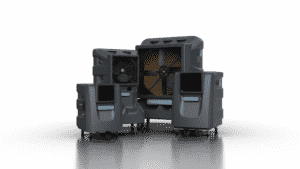
While air conditioning is often the most commonly known cooling solution, it’s not always the best option to achieve your needs. This is especially true in work environments that require the cooling of vast spaces, outdoor areas, or rooms with doors and windows that are open on a regular basis. In these situations, air conditioning is generally prohibitively expensive. In addition, if the space being cooled isn’t an enclosed environment, the outdoor air access will prevent air conditioning from being a viable solution at all.
Unfortunately, the risks posed by excessive heat in work environments simply can’t be ignored. Employees in many work settings face a serious risk of heat illness when temperatures get too hot. In addition, the lost productivity from the heat can significantly impact your bottom line.
Since air conditioning is rarely a good option in work environments, it’s crucial to explore other solutions. Fans – both oscillating and ceiling options – simply push around the hot air already circulating in the room, making them an ineffective way to keep workers cool. Fortunately, there is one solution that provides highly effective results in a wide range of work applications – evaporative cooling.
 As the name implies, evaporative cooling harnesses the power of evaporation to cool the air temperature. When water turns into gas during the evaporation process, the highest energy particles are released first, which results in a temperature drop. Evaporative cooling leverages this scientific process on a large-scale level in order to maintain a cool, comfortable environment.
As the name implies, evaporative cooling harnesses the power of evaporation to cool the air temperature. When water turns into gas during the evaporation process, the highest energy particles are released first, which results in a temperature drop. Evaporative cooling leverages this scientific process on a large-scale level in order to maintain a cool, comfortable environment.
No artificial refrigerants or coolants are used with evaporative cooling. Instead, you experience cool, refreshing air that is natural, clean, and healthy for you. In addition, the energy consumption required as part of the evaporative cooling process is dramatically less than what is necessary with air conditioning. This significantly lowers the costs associated with maintaining a cool, comfortable environment for your workers.
You’ll experience a variety of benefits from evaporative cooling, including:
When the temperature is at or below 32°F, water is frozen and remains in a solid state. Once the temperature reaches 212°F, water boils and turns into steam (its gas state). When water is in either its solid or gas form, it cannot provide any evaporative cooling effect. In order to achieve the benefits of evaporative cooling, water must be in its liquid state.
When water is in its liquid form, the amount of cooling you can expect from the evaporation process depends on the difference between the wet bulb and dry bulb temperatures:
In general, you’ll experience the most dramatic evaporative cooling effects when the dry bulb temperature is very high, and the wet bulb temperature is very low. In addition, the greater the disparity between these two temperatures, the higher your evaporation efficiency will be.
In most instances, humidity levels go down as temperatures rise. As a result, extremely hot days often present the ideal circumstances for highly effective evaporative cooling. That being said, evaporative cooling technology has become highly advanced in recent years. As a result, our Portacool evaporative coolers are able to deliver significant cooling benefits even when conditions are very humid.
Evaporative cooling is actually one of the oldest methods for combatting hot temperatures. It was used by the ancient Romans, Greeks, and Egyptians thousands of years ago. These early civilizations would hang wet mats in front of tent and window openings. As the hot air would blow through the mats, the water would evaporate and produce cool air that kept the inside temperature more comfortable. These mats were the earliest version of what has become the cooling media used in modern evaporative coolers.
Evaporative cooling became more advanced in the 15th century with the invention of mechanical ventilation fans. In the 18th century, British textile manufacturers continued pushing this technology forward by combining cooling towers and fans.
Today, evaporative coolers are used by many businesses in a wide range of industries to keep their employees cool, safe and productive. These devices have the ability to provide massive amounts of cool air. Hot outside air flows over evaporative media inside the cooler. The water on the media evaporates, causing the air temperature to drop dramatically. This cooler air is blown throughout the room. Evaporative coolers can lower the air temperature in the space being cooled by as much as 30 degrees F.
Portacool has been an industry leader in evaporative cooling technology since 1990. We offer four distinct lines of evaporative coolers to ensure your needs are met. All of our evaporative coolers are made at our Center, Texas manufacturing facility. In addition, our evaporative media is made by our subsidiary company, Kuul, ensuring they are completed to the exact specifications of our evaporative coolers. Kuul evaporative media uses the highest quality raw materials, and it is the only evaporative media made in the US.
 Portacool evaporative coolers can be used for just about any business application, and they are also ideally suited to providing cooling for residential patios and home workshops. Some of the most common applications for our evaporative coolers include:
Portacool evaporative coolers can be used for just about any business application, and they are also ideally suited to providing cooling for residential patios and home workshops. Some of the most common applications for our evaporative coolers include:
You can find a retailer near you to purchase an evaporative cooler or contact us to learn more.